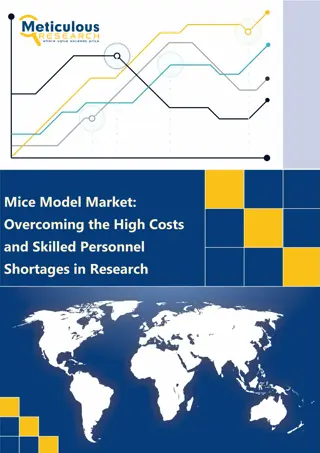Understanding Gene Editing with CRISPR/Cas9 Technology
Explore the fascinating world of CRISPR/Cas9 gene editing technology through sessions led by experts like Roy Campbell and Howard Robinson. Delve into the working of gene editing, the CRISPR system, and the role of Cas9 enzyme. Learn about CRISPR's origin in prokaryotic organisms and its potential f
0 views • 33 slides
Anticipating Meteoric Surge _ Meticulous Research Forecasts Mice Model Market to Reach $2.48 Billion by 2030
Mice Model Market By Mice Type (Inbred, Hybrid), Services (Breeding, Cryopreservation, Quarantine), Technology (CRISPR, Nuclear Transfer), Application (Oncology, Cardiology, Neuro), End User (Research, Academia, Pharmaceutical) - Global Forecast to 2030
1 views • 2 slides
Mice Model Market: The Importance of Breeding Services in Biomedical Research
Mice Model Market By Mice Type (Inbred, Hybrid), Services (Breeding, Cryopreservation, Quarantine), Technology (CRISPR, Nuclear Transfer), Application (Oncology, Cardiology, Neuro), End User (Research, Academia, Pharmaceutical) - Global Forecast to 2
0 views • 4 slides
Investigating HIF-1 and Apold-1 in Endothelial Permeability at the Blood-Brain Barrier
Understanding endothelial permeability at the blood-brain barrier is crucial for drug delivery to the brain. This research aims to identify a potential mechanism between HIF-1 and Apold-1 specific to cerebral epithelial cells that may impact the integrity of the blood-brain barrier. The study involv
0 views • 14 slides
Genetic Tweaks for Pain-Free Life: Ethical Considerations and Future Possibilities
Post-Darwinian life could potentially alleviate physical and mental pain through genetic tweaks, sparking debates on ethical implications, human genetic experimentation, and the use of technologies like CRISPR. The discovery of FAAH and FAAH-OUT genes offers insights into reducing pain sensation and
0 views • 12 slides
Investigating the Role of Amino Acid 381 in BK Channel Clustering
The study explores the significance of amino acid 381 in the function of dystrophin to localize SLO-1 in C. elegans. By utilizing the T381I mutation, the research aims to determine whether a SLO-1 BK channel with this mutation exhibits a clustered or non-clustered phenotype. Proposed methods involve
0 views • 17 slides





